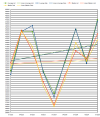Value Ninja
Sophomore Member
- Joined
- Nov 25, 2003
- Professional Status
- Certified Residential Appraiser
- State
- Alabama
The new Selling Guide update requires that we "Establish a minimum timeframe of 12 months from which the overall market trend must be derived". Does OVERALL MARKET TREND in this context refer to the box on the Neighborhood section of the URAR? This is question #1
I work in a coastal, seasonal market which very predictably (when the world is normal at least), increases in the Spring and Summer and decreases from late Fall through early Winter. Values and total# of sales are very highly correlated. There are few transitional months where values are actually stable, but most of the time they are either increasing or decreasing and I make adjustments reflecting this reality. However, a linear trend line on a 12 month chart may be flat (stable). So Question #2. In my market, let's say I am 4 months into a increasing or decreasing seasonal cycle, but the 12 month trend is stable, Does FNMA want me to check to STABLE box (based on question 1 above or the established direction the market has actually been moving in for months?
I should say that over my 20+ years, I have waffled a bit with this.. At some points in my career I have described it as stable but with seasonal effects and checked the STABLE box referincing a stable 12 months linear trend line. At other times, I have described it narratively exactly the same way but have checked whatever box was appropriate for the medium term established trend.
Also, while FNMA's example chart shows a lack of real world/practical understanding of both the messiness of real estate data and statistics in general, it does at least draw attention to the fact that markets can move in a non-linear direction, and adjustments should reflect the market. Maybe that will help with lack of understanding from reviewers on this specific issue.
I work in a coastal, seasonal market which very predictably (when the world is normal at least), increases in the Spring and Summer and decreases from late Fall through early Winter. Values and total# of sales are very highly correlated. There are few transitional months where values are actually stable, but most of the time they are either increasing or decreasing and I make adjustments reflecting this reality. However, a linear trend line on a 12 month chart may be flat (stable). So Question #2. In my market, let's say I am 4 months into a increasing or decreasing seasonal cycle, but the 12 month trend is stable, Does FNMA want me to check to STABLE box (based on question 1 above or the established direction the market has actually been moving in for months?
I should say that over my 20+ years, I have waffled a bit with this.. At some points in my career I have described it as stable but with seasonal effects and checked the STABLE box referincing a stable 12 months linear trend line. At other times, I have described it narratively exactly the same way but have checked whatever box was appropriate for the medium term established trend.
Also, while FNMA's example chart shows a lack of real world/practical understanding of both the messiness of real estate data and statistics in general, it does at least draw attention to the fact that markets can move in a non-linear direction, and adjustments should reflect the market. Maybe that will help with lack of understanding from reviewers on this specific issue.


